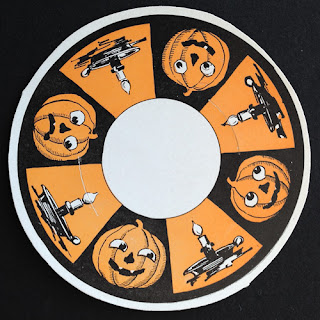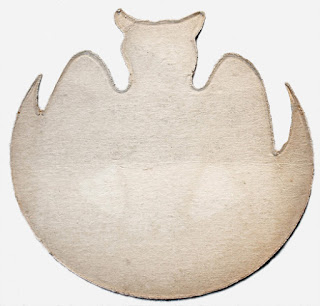Bloody Paper Cuts
Sane Halloween Observer
As a subject introduction, I would point you to an earlier entry that introduces the concept and process of the diecut: Halloween Diecut Quiz. While in the entry that follows here, I will show you examples of true diecuts. I trust that once you know how to spot true paper, you should in theory be able to recognize the opposite.
First you need to know certain companies, especially early era, could change color, size, and paper (thickness, surface) over subsequent releases of a design. Beistle is one such company that you may not always finish a set by collecting known imagery; you have to make sure you have the correct variation of the set. This occurred with their earlier Complete Party Outfits (below) and their later Halloween Party Set (in book, box, and envelope, not shown). I want to account for this - using a couple of Beistle set variation with one more obvious, and one challenging - so that qualities (not variations) indicate real vintage.
The first set (directly following) was printed on thin/medium matte stock, and were punch-outs from a larger sheet. (Examine in detail by clicking the images and I have provided an occasional zoom).
Set 1, Photo 1 (nut cup base)
Set 1, Photo 2 (nut cup base)
Already, you should see that while the circles may not be entirely perfect the arcs are generally smooth and sweeping; in contrast a fake scissor cut is often jagged. Also in this set there is the occasional little blip along the edge. This was the absence of the die, and uncut kept the item in place until the customer was ready to pull from the larger sheet.
Note too that dies cut downward, like a stamp, into the print, so the cut usually creates a softer caving-edge on the top. On the bottom you will notice a lip. (For a truly obvious example, see the image at bottom of these two sets). Also, don't worry too much about alignment issues; the printed image is usually not where the die falls.
Set 1, Photo 3
Set 1, Photo 4
Then here is an image of the nut cup side still in place with the surrounding sheet. This is a great example of how the print doesn't often align with the cuts. But maybe more importantly notice the downward push of the paper around the cut lines, and smoothness of certain curves, especially ones that might be hard to reproduce with a pair of scissors.
Set 1, Photo 5
Set 1, Photo 6
Set 1, Photo 7
This second set is an advanced challenge for the eyes. It's honestly pretty sloppy for an industrial product, but again, look closely. I actually hesitated here to declare some of these true diecuts myself, as they do have some weirdness but see the points below. You can still differentiate these from fakes. Note immediately the changes in art style, a gloss-top/matte-back paper choice and I should also measure.
So we don't have totally perfect circles here in photos 1 and 2 below, but that's the shape of the die, not a casual freehanded cut. This is most likely true vintage because of the neat arcs and the occasional dull blip that is caused by a gap in the die (where the circle would have been physically torn from the surrounding paper - which tells me this was probably also sold in large sheets).
Set 2, Photo 1
Set 2, Photo 2
What really defines this as a true diecut is seen in the slot of photos 3 and 4. As a die pushed down into the paper it forced the printed side just a bit downward as well. There is somewhat of a dip in that slot. It's more obvious from the back, and this is the tell-tale lip I am always going on about. See how the die pushing through the paper caused a raised area around the cut? You will not see that with a scissor or knife cut.
Set 2, Photo 3
Set 2, Photo 4
Okay, well remember I mentioned this set was challenging to a good eye? This piece is actually quite a hastily created die shape and almost appears hand cut. But again I think this is the shape of the die. What tips me to think this is a true diecut - is the slot. Again, as above, we have the slight canyon effect of the die pushing the print side downward in photo 7.
Set 2, Photo 5
Set 2, Photo 6
Set 2, Photo 7
What I would ultimately prefer to do for this second set (particularly the tabbed nutcup sides) would be to hold a piece from this set up against another known set, and see if the outline shape align therefore verifying a die was used to cut each on an assembly line process. This would be where either some previous knowledge or good networking with the Halloween community comes in handy.
Note, that as thickness increases it is often easier to discern the qualities described above. Though it is from neither set mentioned, take this Beistle item for example. The lip on the edge is almost a smallish well-defined track around the edges.
So the image above leads properly to our second 2018 season occurrence.
In this instance, a recommended seller listed an item with an assumption it was a fully designed piece as-is, therefore not altered nor fake. While the imagery was fun, (if somewhat incomplete), the assumption without examination to mechanical operation was disappointing. Creative artists weren't just printing out images and calling them nutcups, invitation, place cards, etc., without forethought that the piece actually worked in the manner expected. Worse yet, the item made its way through the full process of sales, and found itself a new home. This means the seller, either unwittingly or willfully, listed the product regardless of its veracity ---- so as stated in the introduction, buyer be knowledgeable!
Let's take any placecard as a completely random example. The first function of any placecard is placement (perhaps to direct a partygoer at a table), and a manner for identifying that placement. Therefore, placecards are very inventive in offering a place for the name to be written. I think it's rather obvious here below.
But there is something else happening here that is hard to explain, and that is logical image placement in relation to the cut lines. Again, creatives knew cut lines weren't going to line up with the printed image and therefore planned accordingly. If your "diecut" has strange unresolved bits (an indication that you're not getting the full picture near those cut lines) then you probably don't have a true item.
Finally, there is the mechanical function of a placecard. There was an astounding wealth of inventiveness to early designs - and their manner of bending space to stand upright, etc. Above we see not only the diecut's lip around all deliberate edges, but also the use of dulled edges on the die to create a fold line to make this piece stand. If your piece has neither of these, then it is 99.9% unauthentic.
Anyway, I hate to be a killjoy, as apparently close examination of true items versus fake seems to actually offend certain folks. But hopefully you are reading this blog because you have a true curiosity for these items and their fascinating industrial, creative background. As I stated in the previous entry, in writing these articles I have neither contact with current commentators, book authors, nor sales people (that often overlap) in order to prevent a biased conflict of interest.




















